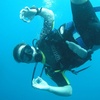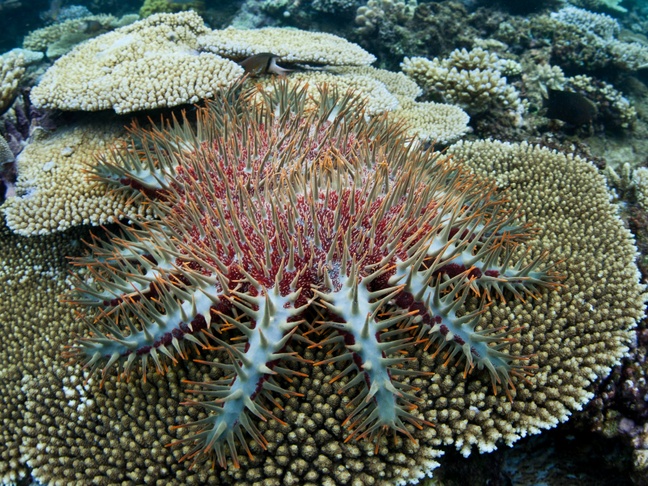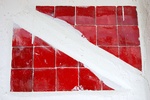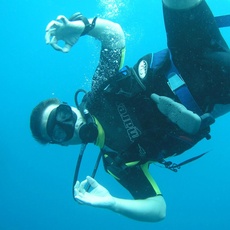Australia » Cairns, Qld
[Dive site]
[Subtitle]
Crown-of-thorns starfish (appearance 1)
Acanthaster planci
Photo by Ethan Daniels (C) All rights reserved
Wrong picture ID? ... let us know!
Example Divers
[Company's slogan]

[Dive leader's name]
[Job title]
[Here you can give a short description of the dive leader, for example:]. [Name] has been a Divemaster since 2012. Before he worked in Key West, Curacao and Koh Tao. [Name] is an excellent Nudibranch-spotter and knows his languages. He speaks Dutch, English, German and Spanish.
You can follow him on facebook.
Crown-of-thorns starfish (appearance 1)
Acanthaster planci
The crown-of-thorns starfish is one of the largest sea stars in the world. Adult's are between 25 to 35 cm and they have up to 21 arms. Its upper surface is covered with venomous thorn-like spines.
It feeds on coral reef polyps by climbing on a living colony. It will turn its stomach outward through the mouth against the healthy coral. It will digest it by excreting enzymes that cause the coral to become a soupy mixture. It absorbs the coral soup through its stomach wall. After the starfish is finished this area of coral is dead, leaving a bleached white stain as a reminder.
An individual starfish can consume up to 6 square meters of living coral reef per year. According to research by the Australian Institue of Marine Science the crown-of-thorns starfish is responsible for the killing of almost 25% of the coral on the Great Barrier Reef since the 1980's.
The crown-of-thorns starfish only hashas a few predators. One of the main predators is the Triton's trumpet, a sea snail which growns up to 60 cm.
Link to description on WikipediA
Surface interval
Time:
1:05
Pressure Group:
D
Dive
1st level
Depth:
32
Time:
0:10
P.G:
G
2nd level
Depth:
24
Time:
0:15
P.G:
K
3rd level
Depth:
12
Time:
0:30
P.G:
O
RNT: 17
+ ABT: 46
TBT: 63
Conditions
Weather
Sunny
Air temperature
35 degrees
Surface conditions
Calm
Water temperature
28 degrees
Current
Weak
Visibility
30 meters
Notes
[Space for comments, such as further details of the dive leader about the dive or the marine life and comments of the customer]
This gallery is made by MyFishGallery's imaginary dive center located in Cairns, Australia. The dive leader shared this gallery with the divers who joined the dive. This means that an exact copy of this gallery has been placed into the personal accounts of these divers. Within there personal accounts they can further edit the gallery to their liking.
Dive centers/Dive leaders can quickly create a gallery via one of the self-created templates. A template already contains geographic information (country, place and dive site) and preselected pictures of marine life. The pictures can be categorized in 'mostly seen', 'regularly seen' and 'sometimes seen'. If you have a rare encounter with marine life which is not included in the template, you can still add it to the gallery outside of the template. In the template you select the pictures of the marine life you saw during the dive. These will be merged into the gallery.
A company's banner will automatically be added to a shared gallery. It contains the company's name, a slogan (option), a logo (3:4 ratio), a link to the company's website, links to the social pages (option per button) and a picture (1:1 ratio) of the dive leader. The name, job title and information about the dive leader will show when hovering the pointer over the picture (desktop) or when the picture is selected (tablet/smartphone).
All input for the company's banner is added via 'My profile' and 'My dive leaders' in the menu (only when dive center rights are assigned).
The dive leader has the possibility to (partly) fill in the dive log: air + water conditions, depths, times and pressure groups. When the divers are logged in there personal accounts they can complete the dive log: air consumption, buddy- + gear information and comments.
A gallery can also be shared by customers, using the social media buttons on the top right or bottom of the screen.

























Comments